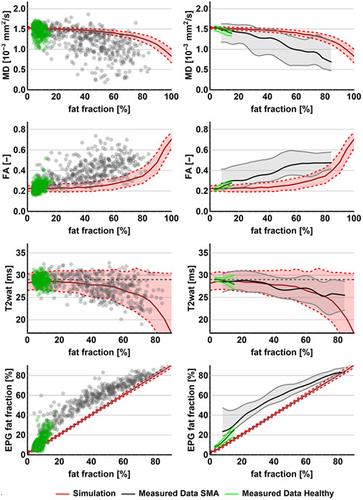当前位置:
X-MOL 学术
›
NMR Biomed.
›
论文详情
Our official English website, www.x-mol.net, welcomes your
feedback! (Note: you will need to create a separate account there.)
Quantitative MRI of skeletal muscle in a cross-sectional cohort of patients with spinal muscular atrophy types 2 and 3.
NMR in Biomedicine ( IF 2.7 ) Pub Date : 2020-07-18 , DOI: 10.1002/nbm.4357 Louise A M Otto 1 , W-Ludo van der Pol 1 , Lara Schlaffke 2 , Camiel A Wijngaarde 1 , Marloes Stam 1 , Renske I Wadman 1 , Inge Cuppen 3 , Ruben P A van Eijk 1, 4 , Fay-Lynn Asselman 1 , Bart Bartels 5 , Danny van der Woude 5 , Jeroen Hendrikse 6 , Martijn Froeling 6
NMR in Biomedicine ( IF 2.7 ) Pub Date : 2020-07-18 , DOI: 10.1002/nbm.4357 Louise A M Otto 1 , W-Ludo van der Pol 1 , Lara Schlaffke 2 , Camiel A Wijngaarde 1 , Marloes Stam 1 , Renske I Wadman 1 , Inge Cuppen 3 , Ruben P A van Eijk 1, 4 , Fay-Lynn Asselman 1 , Bart Bartels 5 , Danny van der Woude 5 , Jeroen Hendrikse 6 , Martijn Froeling 6
Affiliation

|
The aim of this study was to document upper leg involvement in spinal muscular atrophy (SMA) with quantitative MRI (qMRI) in a cross‐sectional cohort of patients of varying type, disease severity and age. Thirty‐one patients with SMA types 2 and 3 (aged 29.6 [7.6‐73.9] years) and 20 healthy controls (aged 37.9 [17.7‐71.6] years) were evaluated in a 3 T MRI with a protocol consisting of DIXON, T2 mapping and diffusion tensor imaging (DTI). qMRI measures were compared with clinical scores of motor function (Hammersmith Functional Motor Scale Expanded [HFMSE]) and muscle strength. Patients exhibited an increased fat fraction and fractional anisotropy (FA), and decreased mean diffusivity (MD) and T2 compared with controls (all P < .001). DTI parameters FA and MD manifest stronger effects than can be accounted for the effect of fatty replacement. Fat fraction, FA and MD show moderate correlation with muscle strength and motor function: FA is negatively associated with HFMSE and Medical Research Council sum score (τ = −0.56 and −0.59; both P < .001) whereas for fat fraction values are τ = −0.50 and −0.58, respectively (both P < .001). This study shows that DTI parameters correlate with muscle strength and motor function. DTI findings indirectly indicate cell atrophy and act as a measure independently of fat fraction. Combined these data suggest the potential of muscle DTI in monitoring disease progression and to study SMA pathogenesis in muscle.
中文翻译:

2 型和 3 型脊髓性肌萎缩症患者横断面队列中骨骼肌的定量 MRI。
本研究的目的是在不同类型、疾病严重程度和年龄的患者横断面队列中,通过定量 MRI (qMRI) 记录大腿受累于脊髓性肌萎缩症 (SMA)。31 名 2 型和 3 型 SMA 患者(年龄 29.6 [7.6-73.9] 岁)和 20 名健康对照者(年龄 37.9 [17.7-71.6] 岁)在 3 T MRI 中使用由 DIXON、T2 映射组成的协议进行评估和扩散张量成像(DTI)。将 qMRI 测量值与运动功能(Hammersmith Functional Motor Scale Expanded [HFMSE])和肌肉力量的临床评分进行比较。与对照组相比,患者的脂肪分数和各向异性分数 (FA) 增加,平均扩散系数 (MD) 和 T2 降低(所有P< .001)。DTI 参数 FA 和 MD 表现出比脂肪替代效应更强的影响。脂肪分数、FA 和 MD 显示出与肌肉力量和运动功能的中等相关性:FA 与 HFMSE 和医学研究委员会总分呈负相关(τ = -0.56 和 -0.59;两者P < .001),而脂肪分数值为 τ = -0.50 和 -0.58,分别(P < .001)。这项研究表明 DTI 参数与肌肉力量和运动功能相关。DTI 发现间接表明细胞萎缩,并作为独立于脂肪分数的衡量标准。结合这些数据表明肌肉 DTI 在监测疾病进展和研究肌肉 SMA 发病机制方面的潜力。
更新日期:2020-09-03
中文翻译:

2 型和 3 型脊髓性肌萎缩症患者横断面队列中骨骼肌的定量 MRI。
本研究的目的是在不同类型、疾病严重程度和年龄的患者横断面队列中,通过定量 MRI (qMRI) 记录大腿受累于脊髓性肌萎缩症 (SMA)。31 名 2 型和 3 型 SMA 患者(年龄 29.6 [7.6-73.9] 岁)和 20 名健康对照者(年龄 37.9 [17.7-71.6] 岁)在 3 T MRI 中使用由 DIXON、T2 映射组成的协议进行评估和扩散张量成像(DTI)。将 qMRI 测量值与运动功能(Hammersmith Functional Motor Scale Expanded [HFMSE])和肌肉力量的临床评分进行比较。与对照组相比,患者的脂肪分数和各向异性分数 (FA) 增加,平均扩散系数 (MD) 和 T2 降低(所有P< .001)。DTI 参数 FA 和 MD 表现出比脂肪替代效应更强的影响。脂肪分数、FA 和 MD 显示出与肌肉力量和运动功能的中等相关性:FA 与 HFMSE 和医学研究委员会总分呈负相关(τ = -0.56 和 -0.59;两者P < .001),而脂肪分数值为 τ = -0.50 和 -0.58,分别(P < .001)。这项研究表明 DTI 参数与肌肉力量和运动功能相关。DTI 发现间接表明细胞萎缩,并作为独立于脂肪分数的衡量标准。结合这些数据表明肌肉 DTI 在监测疾病进展和研究肌肉 SMA 发病机制方面的潜力。











































 京公网安备 11010802027423号
京公网安备 11010802027423号